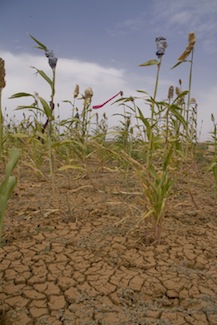Friday, April 19, 2024
News and Views from the Global South
“A Catastrophic Year” as Hunger Crisis Looms over Sahel
- Seven out of the eight governments in the Sahel – the arid zone between the Sahara desert in North Africa and Sudan’s Savannas in the south – have taken the unprecedented step of declaring emergencies as 12 million people in the region are threatened by hunger.
“It’s a catastrophic year. The drought is severe. We need urgent intervention to prevent a famine,” warns Ahmed Weddady, national director in the Ministry of Water and Sanitation of Mauritania, the country with the world’s least amount of potable water, which suffered the worst harvest shortfall in the region. A third of its population already suffers severe food insecurity.
After a drought destroyed the majority of the harvest in the Sahel late last year, rural populations throughout the region have started to run out of food in early February. That’s a good six months before the next harvest is expected.
But the world’s rich nations, plagued by financial crises and having just spent millions of dollars in emergency aid during last year’s Somalia famine, have been slow to respond to the appeals. Barely half of the 650 million dollars needed by the United Nations (U.N.) alone have been pledged. Other aid agencies say they are equally short of funds.
The catch: the longer donors wait, the more lives will be lost and the more expensive it will be to help, says José Luis Fernandez, regional emergency coordinator of the Food and Agriculture Organization of the U.N. (FAO): “That’s the lesson we learnt in Somalia. We don’t have time to lose. We need to mobilise support now.”
It costs 10 to 20 times more to airlift food into an affected area than to ship it. Equally, it costs 80 dollars a day to treat a malnourished child, while it would cost only one dollar a day to prevent the child’s malnutrition if the money was invested in development programmes in advance.
The problem in the Sahel is that exactly such long-term development programmes are barely existent. The region suffers from cyclic droughts that have led to low resilience among the population. Even in a “normal” year, half of all children under five, the most vulnerable, suffer chronic malnutrition. That means the step to reaching a full-blown hunger crisis is small.
Climate change combined with population growth, acute poverty, poor access to basic services, changing migration patterns and weak governance, competition over scarce resources and conflict potential have intensified in a region where the majority is dependent on rain-fed agriculture and livestock for survival.
That is why development experts stress the fact that emergency aid can only help the Sahel in the short-term, while long-term, structural programmes are needed to assist the region in creating resilience to recurring droughts. “Such programmes should include investments in agricultural development, health and social protection services, water and sanitation as well as adaptation to climate change,” says Johannes Schoors, country director of international aid organisation CARE in Niger, where more and more people go hungry due to the drought.
Even if all the needed funds were pledged, providing humanitarian aid will be difficult and complex. The Sahel is a vast, sprawling region, with many villages in remote and inaccessible places, making it a logistical nightmare to distribute food and other supplies.
“Because people live very scattered, logistics are complicated and expensive. Distances to reach affected people are enormous, roads very bad and sometimes non-existent,” notes Schoors.
What makes the situation even worse is the recent upsurge of violence in the region. In January, fighting erupted between Mali’s army and nomadic Tuareg rebels seeking a sovereign homeland, while Nigeria experiences violence perpetrated by Islamist sect Boko Haram, combined with ongoing operations by a regional Al-Qaeda group, Al-Qaeda in the Maghreb.
According to the U.N. Children’s Fund (UNICEF), which tries to get life-saving aid to severely malnourished children in the region, first supply trucks have been prevented from reaching food insecure areas in Niger, which borders on northern Nigeria.
“It is becoming more and more difficult to reach people in need. We face similar difficulties in northern Mali. We foresee a period of great instability in the region,” worries UNICEF regional nutrition advisor for West and Central Africa Felicité Tchibindat.
The conflicts have caused many to flee their homes. At least 22,000 refugees had flooded into Mauritania, Burkina Faso and Niger by early February, crossing the border into the most food insecure areas in those countries.
“Having to deal with displaced people in areas where residents already suffer causes additional difficulties in reaching them with aid, as well as social tensions and conflict potential,” says Fernandez.
The quadruple burden of drought, structural problems, violence and refugees begs for a swift response, he adds. But for now, many aid agencies cannot scale up their efforts until they receive the necessary funds.

 Print
Print




